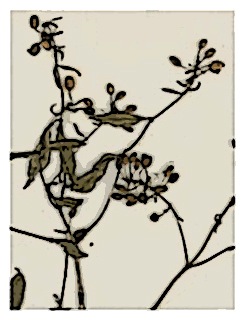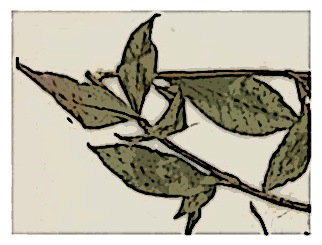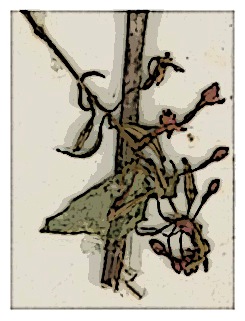
The Genus Fuchsia
Section Jimenezia
(one species)
This section's name, along with the single species that it contains, is a nod to Alfonso Jiménez-Muñez, a botanist and professor of Agronomy and Biology at the National University of Costa Rica, as well as the director of the National Museum of Costa Rica. It was Prof. Jiménez who first recognized and brought to the attention of other botanists that F. jimenezii was a species distinct from F. arborescens or F. paniculata, with which it was usually confused. The type on which the new species was published in his honor by Breedlove, Berry & Raven in 1983 was collected by Thomas C. Emmel in 1967 at Puntarenas in Costa Rica.
Name: Fuchsia sect. Jimenezia Breedlove, P.E.Berry & P.H.Raven, 1982.
Typus: F. jimenezii Breedlove, P.E.Berry & P.H.Raven
Section Jimenezia
(one species)
This section's name, along with the single species that it contains, is a nod to Alfonso Jiménez-Muñez, a botanist and professor of Agronomy and Biology at the National University of Costa Rica, as well as the director of the National Museum of Costa Rica. It was Prof. Jiménez who first recognized and brought to the attention of other botanists that F. jimenezii was a species distinct from F. arborescens or F. paniculata, with which it was usually confused. The type on which the new species was published in his honor by Breedlove, Berry & Raven in 1983 was collected by Thomas C. Emmel in 1967 at Puntarenas in Costa Rica.
Name: Fuchsia sect. Jimenezia Breedlove, P.E.Berry & P.H.Raven, 1982.
Typus: F. jimenezii Breedlove, P.E.Berry & P.H.Raven

F. jimenezii Breedlove, P.E.Berry & P.H.Raven
Panama & Costa Rica. Scattered in mostly secondary vegetation of wet evergreen cloud forests from Chiriqui Province of northern Panama to the northernmost extension of the Puntarenas Province of Costa Rica at elevations from 1,500 to 1,900 meters.
Flowering is throughout the year.The distinguishing features of this species is that it is totally glabrous and its reflexed stamens are only also found in Fuchsia sect. Encliadra.

Habit: Scandent subshrub 0.5 to 1.5 ( to 2) meters tall, glabrous throughout. Branchlets 10 to 5o cm long, 1 to 3 mm thick, quadrangular; older branches terete, with pale tan, finely fissured bark.
Leaves: Opposite, subcoriaceous, elliptic to lance-elliptic, acute at base, acute to acuminate at apex, (3 to) 5 to 11.5 cm long, (1 to) 2.5 to 5 cm wide, dark green above, flushed purple beneath; secondary veins ten to twelve on either side of the midvein, margin subentire to denticulate with small, glandular teeth; petiole stout, 1 to 2 mm thick, red, 4 to 9 mm long; stipules semisucculent, deltoid, dark when dry, 0.8 to 1.0 mm long and wide, often connate, deciduous.
Flowers: Numerous in terminal racemes, rarely axillary, or occasionally in two to three-branched panicles, rachis 5 to 20 cm long, pedicels erect to spreading, slender, 6 to 12 mm long, elongating up to 18 mm long in fruit, ovary cylindrical-fusiform, 4 to 6 mm long, about 3 mm thick, lustrous red-pink, floral tube obconic to sub cylindric, 2.5 to 4.5 mm long, 1.5 to 2.5 mm wide at base, widening to 2.5 to 4.5 mm wide at rim, sepals broadly lanceolate, 4 to 6 mm long, 2.5 to 3.5 mm wide, apex acute, spreading, tube and sepals red to rose-red, petals rose-pink, suborbicular to ovate, 4 to 6 mm long, 3 to 4 mm wide, rounded at the base, rounded to acute at the apex, nectary an irregularly to quadri-lobed ring-shaped disc adnate to the base of the floral tube, 1 to 1.5 mm high, filaments dull red, the antisepalous filaments erect and exserted above the rim of the tube, 1 to 1.5 mm long,

Fruit: The berry is subglobose, 10 to 12 mm long, about 10 mm thick when ripe, light to dark red, lustrous.
Seeds: Reddish, 0.9 to 1.2 mm long and 0.5 to 0.7 mm thick.

Chromosomes: Gametic chromosome number n = 11.
Authors—Breedlove, Berry & Raven 1982.
Original publication—Ann. Missouri Bot. Gard. 69: 221 1982.
Synonyms—None.
Herbarium Specimens—California Academy 1, California Academy 2; New York; Smithsonian; Texas.
(Illustrations—1. See ➤ F. jimenezii, Field Museum, Neotropical Plant Photos, Photo ID RF31; 2. Detail of plant specimen at the California Academy of Sciences.)
